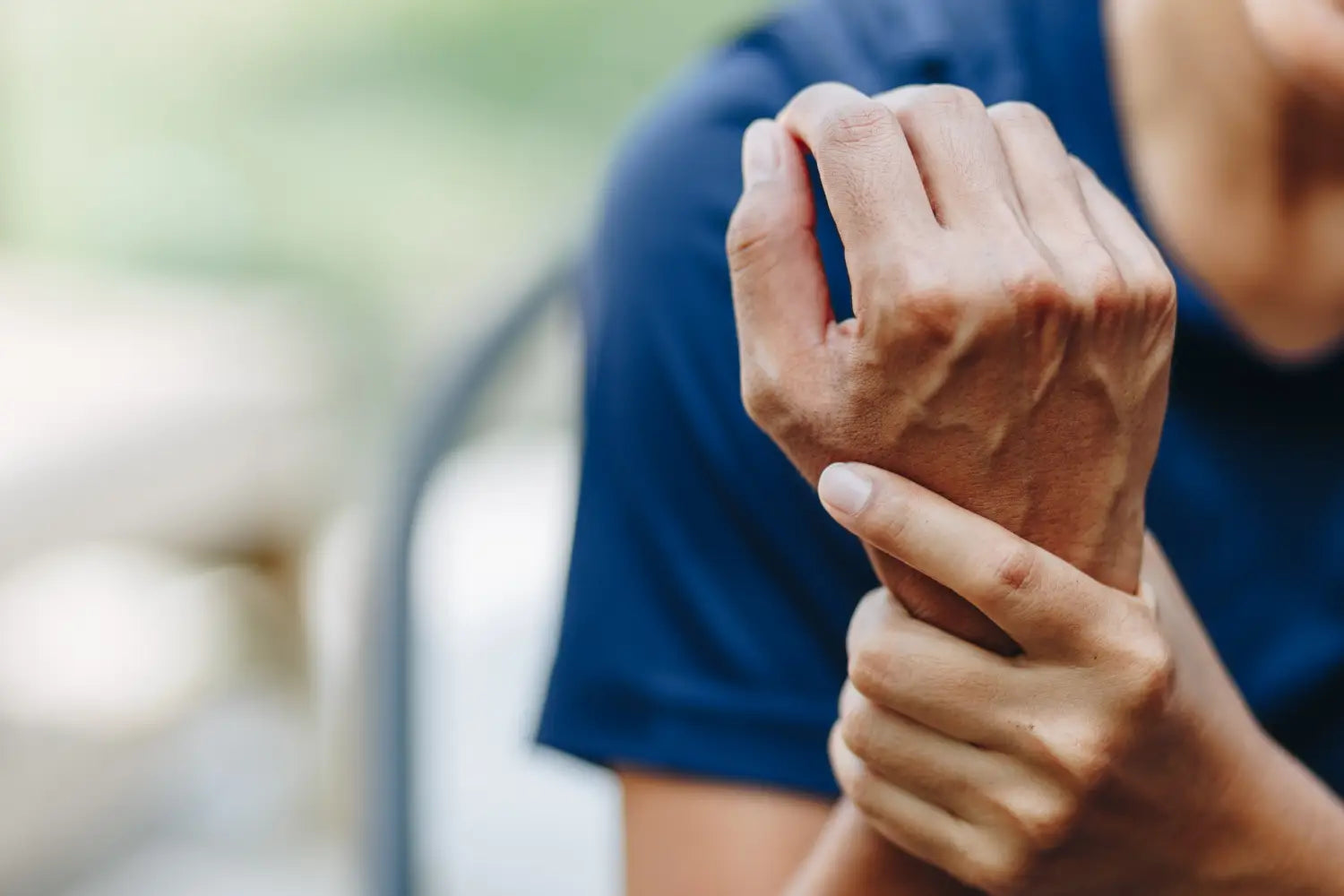Medically Reviewed By | Dr. Kate Panawash, PT, NCS, DPT
Repetitive motion injuries have become an increasingly common ailment in our contemporary world, thanks in no small part to the demands of many modern professions and daily activities. From the ceaseless tapping of a keyboard to the repetitive motions on an assembly line, our bodies are subjected to a consistent set of actions that can, over time, lead to discomfort and injury.
Whether it's a subtle ache in the wrist or a pronounced discomfort in the shoulder, these injuries often stem from actions that seem harmless at first but can have significant repercussions when performed incessantly.
Recognizing, understanding, and ultimately preventing these injuries is paramount for both our professional productivity and personal well-being.
What Are Repetitive Motion Injuries?
Repetitive motion injuries, often abbreviated as RMIs, are injuries to the muscles, nerves, ligaments, and tendons caused by repetitive movement and overuse of a specific part of the body. These injuries are primarily brought on by performing the same motion over and over again without adequate rest or variation, thereby placing undue stress on a particular body part.
Over time, this stress can cause wear and tear, leading to inflammation, pain, and reduced function. It's not just the repetition but often the combination of repetition, force, and suboptimal postures that contribute to these injuries.
Differentiating Between Terms
Navigating the landscape of repetitive motion injuries means coming across a plethora of terms that, while related, hold distinct nuances. For instance, "repetitive strain injury" and "repetitive motion disorders" are terms that might be used interchangeably, but they serve different functions in medical parlance.
Repetitive Strain Injury (RSI) is a broad term that encapsulates pain felt in muscles, tendons, and nerves caused by repetitive use, overuse, and sustained activity.
On the other hand, Repetitive Motion Disorders (RMDs) are a collection of disorders specifically tied to repeated movements, pointing toward conditions such as carpal tunnel syndrome or tendinitis.
Grasping these distinctions not only aids in understanding but also in clear communication with healthcare professionals.
What Are Common Types of Repetitive Motion Injuries?
The realm of repetitive motion injuries is vast, with several conditions falling under its umbrella.
Here are some of the most common ones:
- Carpal Tunnel Syndrome: One of the most frequently diagnosed RMIs, this condition is characterized by numbness, tingling, or weakness in the hand, stemming from pressure on the median nerve in the wrist.
- Tendinitis:An overuse injury where tendons — the bands that connect muscles to bones — become irritated or inflamed.
- Tennis Elbow (Epicondylitis): Despite its name, it's not exclusive to tennis players. It arises due to repetitive wrist and forearm activities, causing pain around the outside of the elbow.
- Golfer’s Elbow: This is similar to tennis elbow but affects the inside of the elbow, primarily caused by overuse of the wrist and fingers.
- Rotator Cuff Injuries: These injuries pertain to the shoulder and can manifest from tasks that involve repeated overhead arm motions.
- Trigger Finger: This condition is marked by one or more fingers getting stuck in a bent position, mainly due to repetitive gripping. Katelyn Panawash, Doctor of Physical Therapy (DPT) and Board Certified Neurologic Clinical Specialist (NCS), suggests trying tendon glide exercises if this sounds like something you struggle with.
- Bursitis: The inflammation of the bursae, small fluid-filled pads that act as cushions among your bones and the tendons and muscles near your joints.
Understanding the specific types of RMIs helps in pinpointing the root causes, ensuring accurate treatment, and promoting efficient preventive measures. Each of these injuries, while associated with repetitive motions, has its unique triggers and manifestations, making individualized attention essential for recovery and prevention. Dr. Panawash recommends discussing your symptoms with your healthcare provider or getting a physical therapy evaluation to find a treatment plan tailored to your specific needs.
What Are the Common Symptoms of RMIs?
The toll of repetitive motion injuries isn't just limited to pain; there's a constellation of symptoms that can indicate these conditions.
Some of the most prevalent include:
- Discomfort in the affected area often intensifies with continued activity.
- Numbness is particularly noticeable in conditions like carpal tunnel syndrome.
- Tingling sensations can sometimes be accompanied by a burning sensation.
- Reduced strength or functionality in the affected part of the body.
- Swelling, especially near joints or other musculoskeletal structures.
The appearance of these symptoms often acts as an early warning system, alerting the individual to the potential onset of a more severe injury. “Seeking out care early on is incredibly helpful in preventing and reducing the severity of these ailments,” Dr. Panawash stresses. “If symptoms are ignored too long it can result in increased time off work, impact your daily activities, and lead to a prolonged recovery.”
Causes and Risk Factors
While the primary trigger for RMIs is repetitive action, it's essential to dig deeper to understand the myriad causes and risk factors involved. Repetitive tasks, especially in settings like the assembly line, can pose significant threats due to their monotonous nature.
Meanwhile, work environments in healthcare can also be particularly taxing, given the demands of patient care, which often require repetitive movements.
Yet, it's not just the nature of the task but how it's executed. Poor posture can compound the effects of repetition, leading to undue strain on particular muscles and ligaments. As touched on previously, awkward positions — especially if maintained for extended periods — can also be detrimental.
Over time, these factors can challenge the musculoskeletal system, putting excessive strain on ligaments and other structures, leading to conditions such as tendinitis and bursitis.
What Are the Treatment Options for RMIs?
When it comes to addressing the repercussions of repetitive motion injuries, timely intervention can significantly improve outcomes. It's crucial to combine professional guidance with supportive measures.
Here are some proven treatments and supports:
- Physical Therapy: Often the first line of treatment, it focuses on strengthening and stretching exercises to restore functionality. Dr. Panawash adds that “a thorough evaluation will help identify the other areas of recovery you may be neglecting like sleep, nutrition, and stress management. These are all key to helping the body recover optimally.”
- Medications: Over-the-counter pain relievers or prescription medications can help manage pain and reduce inflammation. “It’s important to remember that these don't solve the root cause of the problem and should be a small part of RMI management,” Dr. Panawash notes.
- Surgery: In severe cases where conservative treatments don't work, surgical intervention might be considered.
- Support Products: Incrediwear products are designed to support blood flow, soothe discomfort, and maintain a healthy recovery. For instance, our innovative fabric technology can provide much-needed relief and aid in the healing process.
Prevention and Adaptive Strategies
Given that an ounce of prevention is worth a pound of cure, integrating adaptive strategies into daily routines can go a long way.
Here are some tips:
- Regular Breaks: Intermittently resting the body parts most at risk can reduce strain.
- Ergonomic Workspaces: Adjusting your workspace can help maintain a natural posture and reduce the risk of injury. “Investing in a professional ergonomic assessment is a great way to improve your and your work area's longevity,” Dr. Panawash comments.
- Exercise and Stretch: Incorporate exercises that counteract repetitive motions and stretch regularly. Dr. Panawash also notes that “seeing a physical therapist is a great way to identify and target your specific needs. There, it’s important to consider the activities you do outside of work as well to craft a comprehensive plan.”
- Use of Supportive Wear: Our Fingerless Circulation Gloves can be beneficial for those noticing early symptoms, especially in the hands and fingers. While not intrusive, these gloves can support circulation and overused areas.
Conclusion
At Incrediwear, our mission is to contribute to a world where repetitive motion injuries are better understood, more effectively treated, and, most importantly, minimized. As we advance in our contemporary world, it's imperative that we not only evolve in our professions but also in how we care for our bodies.
Armed with knowledge and the right tools, we believe everyone can navigate the demands of modern life with health and vigor. Let's prioritize our well-being today and always.
Sources:
Repetitive Motion Injuries | ColumbiaDoctors - New York
Repetitive Strain Injury (RSI): Causes, Symptoms & Treatment | Cleveland Clinic
Read more

Medically Reviewed By | Dr. Kate Panawash, PT, NCS, DPT Our hands are indispensable tools, unspeakably important in our daily lives. Whether it's gripping a steering wheel, typing a message, or pre...

Medically Reviewed By | Dr. Kate Panawash, PT, NCS, DPT Our hands are indispensable tools, unspeakably important in our daily lives. Whether it's gripping a steering wheel, typing a message, or pre...






Leave a comment
All comments are moderated before being published.
This site is protected by hCaptcha and the hCaptcha Privacy Policy and Terms of Service apply.